Impact of Anaemia on Young People: Research Report with UK Case Study
VerifiedAdded on 2020/12/10
|9
|2845
|115
Report
AI Summary
This research report investigates the impact of anaemia on young people, focusing on a case study in the UK. The introduction defines anaemia, highlighting its causes, symptoms, and potential health problems, especially in young individuals. The report aims to articulate the disease, examine its symptoms, analyze its causes, and evaluate prevention strategies. It includes a literature review that explores various themes, such as the articulation of the disease, the symptoms and impact of anaemia, the causes of anaemia, and factors for its prevention. The research methodology section details the research philosophy (interpretive), approach (inductive), strategy (descriptive), and data analysis (qualitative, thematic analysis). Furthermore, it details the data collection methods, emphasizing the use of primary techniques to gather first-hand information through questionnaires. The report concludes with a discussion of the significance of the research and the impact of anaemia on young people's health and development.

RESEARCH PAPER
Paraphrase This Document
Need a fresh take? Get an instant paraphrase of this document with our AI Paraphraser
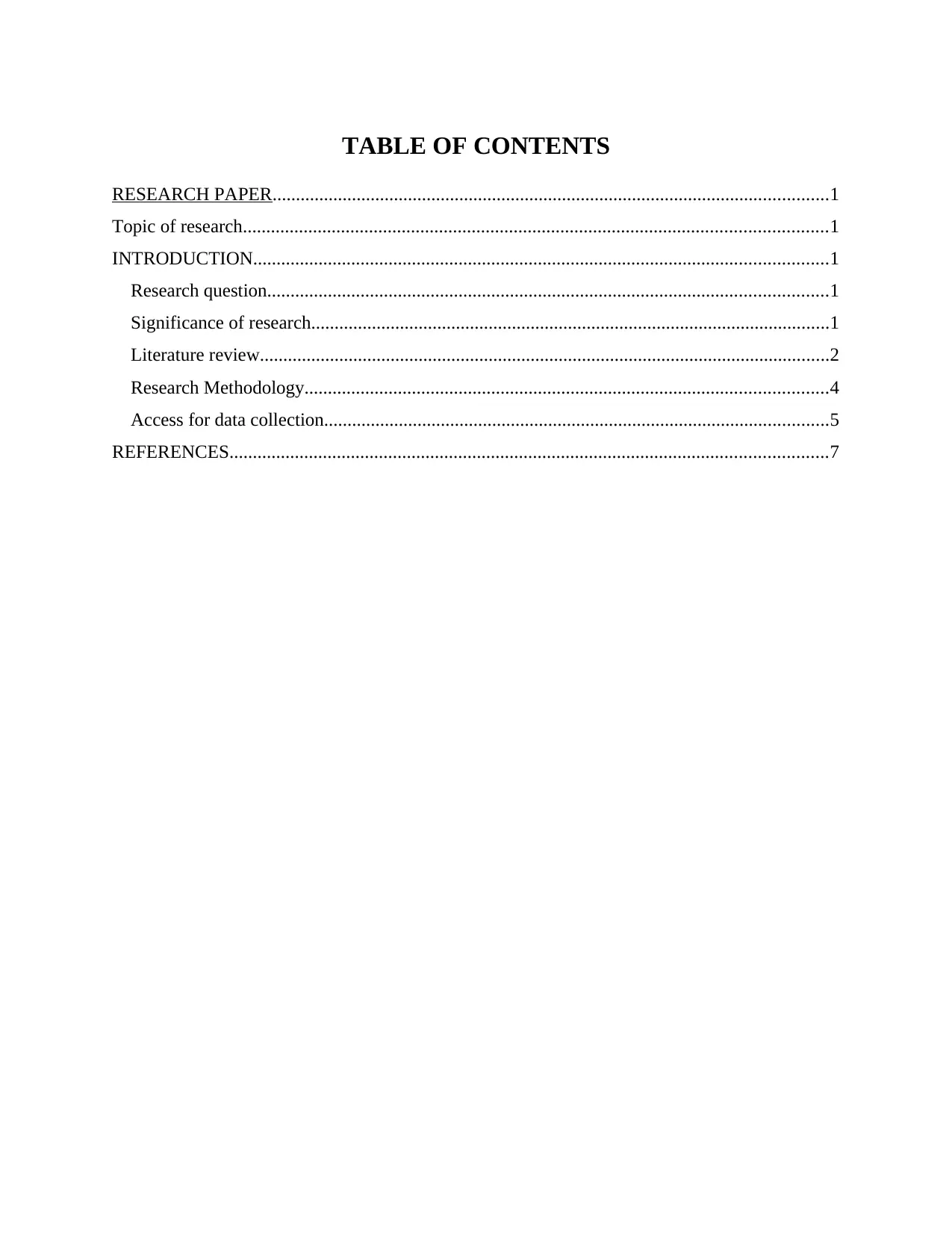
TABLE OF CONTENTS
RESEARCH PAPER.......................................................................................................................1
Topic of research.............................................................................................................................1
INTRODUCTION...........................................................................................................................1
Research question........................................................................................................................1
Significance of research...............................................................................................................1
Literature review..........................................................................................................................2
Research Methodology................................................................................................................4
Access for data collection............................................................................................................5
REFERENCES................................................................................................................................7
RESEARCH PAPER.......................................................................................................................1
Topic of research.............................................................................................................................1
INTRODUCTION...........................................................................................................................1
Research question........................................................................................................................1
Significance of research...............................................................................................................1
Literature review..........................................................................................................................2
Research Methodology................................................................................................................4
Access for data collection............................................................................................................5
REFERENCES................................................................................................................................7
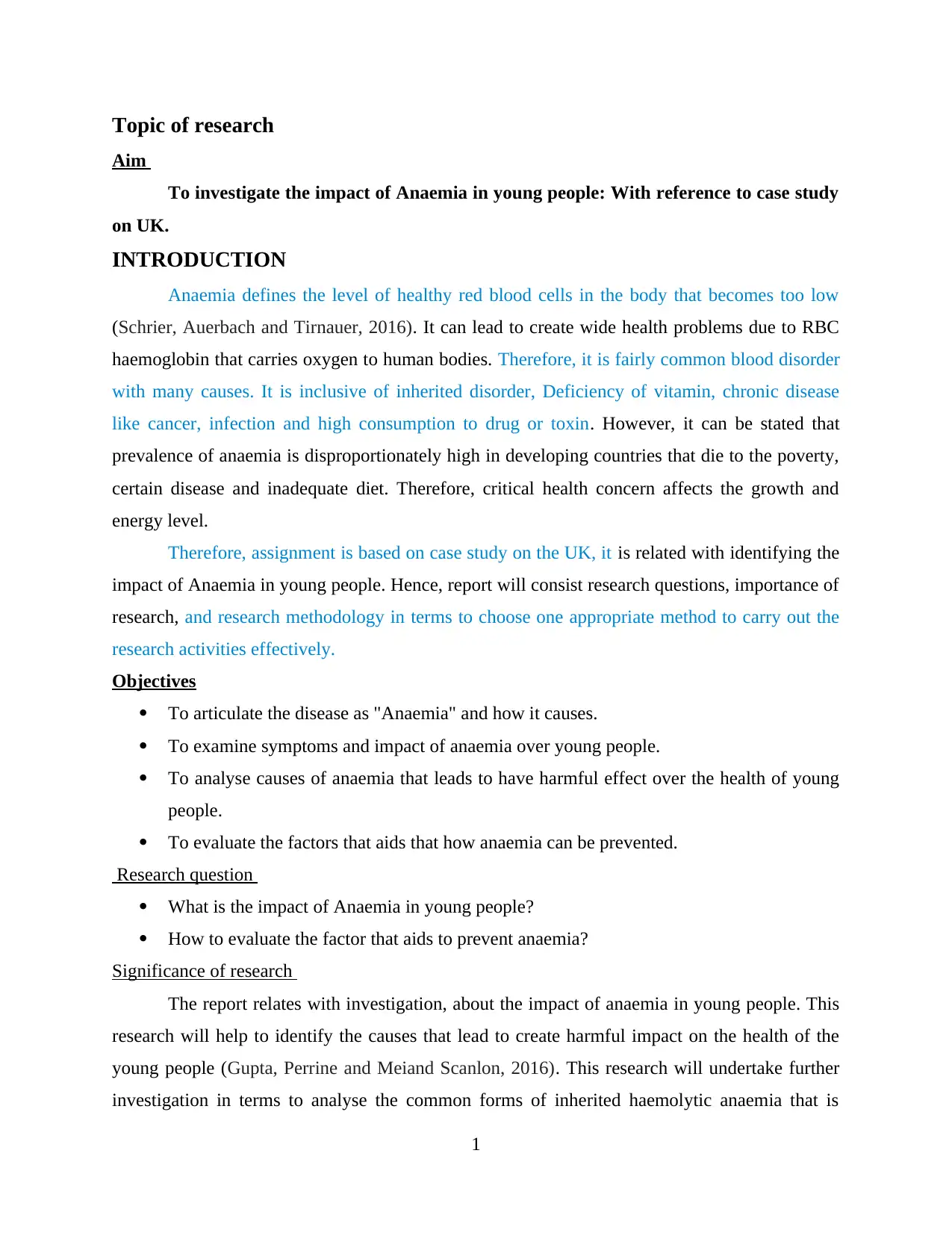
Topic of research
Aim
To investigate the impact of Anaemia in young people: With reference to case study
on UK.
INTRODUCTION
Anaemia defines the level of healthy red blood cells in the body that becomes too low
(Schrier, Auerbach and Tirnauer, 2016). It can lead to create wide health problems due to RBC
haemoglobin that carries oxygen to human bodies. Therefore, it is fairly common blood disorder
with many causes. It is inclusive of inherited disorder, Deficiency of vitamin, chronic disease
like cancer, infection and high consumption to drug or toxin. However, it can be stated that
prevalence of anaemia is disproportionately high in developing countries that die to the poverty,
certain disease and inadequate diet. Therefore, critical health concern affects the growth and
energy level.
Therefore, assignment is based on case study on the UK, it is related with identifying the
impact of Anaemia in young people. Hence, report will consist research questions, importance of
research, and research methodology in terms to choose one appropriate method to carry out the
research activities effectively.
Objectives
To articulate the disease as "Anaemia" and how it causes.
To examine symptoms and impact of anaemia over young people.
To analyse causes of anaemia that leads to have harmful effect over the health of young
people.
To evaluate the factors that aids that how anaemia can be prevented.
Research question
What is the impact of Anaemia in young people?
How to evaluate the factor that aids to prevent anaemia?
Significance of research
The report relates with investigation, about the impact of anaemia in young people. This
research will help to identify the causes that lead to create harmful impact on the health of the
young people (Gupta, Perrine and Meiand Scanlon, 2016). This research will undertake further
investigation in terms to analyse the common forms of inherited haemolytic anaemia that is
1
Aim
To investigate the impact of Anaemia in young people: With reference to case study
on UK.
INTRODUCTION
Anaemia defines the level of healthy red blood cells in the body that becomes too low
(Schrier, Auerbach and Tirnauer, 2016). It can lead to create wide health problems due to RBC
haemoglobin that carries oxygen to human bodies. Therefore, it is fairly common blood disorder
with many causes. It is inclusive of inherited disorder, Deficiency of vitamin, chronic disease
like cancer, infection and high consumption to drug or toxin. However, it can be stated that
prevalence of anaemia is disproportionately high in developing countries that die to the poverty,
certain disease and inadequate diet. Therefore, critical health concern affects the growth and
energy level.
Therefore, assignment is based on case study on the UK, it is related with identifying the
impact of Anaemia in young people. Hence, report will consist research questions, importance of
research, and research methodology in terms to choose one appropriate method to carry out the
research activities effectively.
Objectives
To articulate the disease as "Anaemia" and how it causes.
To examine symptoms and impact of anaemia over young people.
To analyse causes of anaemia that leads to have harmful effect over the health of young
people.
To evaluate the factors that aids that how anaemia can be prevented.
Research question
What is the impact of Anaemia in young people?
How to evaluate the factor that aids to prevent anaemia?
Significance of research
The report relates with investigation, about the impact of anaemia in young people. This
research will help to identify the causes that lead to create harmful impact on the health of the
young people (Gupta, Perrine and Meiand Scanlon, 2016). This research will undertake further
investigation in terms to analyse the common forms of inherited haemolytic anaemia that is
1
⊘ This is a preview!⊘
Do you want full access?
Subscribe today to unlock all pages.

Trusted by 1+ million students worldwide

inclusive of sickle cell disease, thalassemia. Glucose-6-phosphate etc lack of reason can be
identified with terms to knowledge concerning about the nutrition, attitude and practices.
Henceforth, this study aimed at contributing factors towards the improvement of adherence to
hematinics and folic acid supplementation with terms to mitigate the anaemia in young children
(Siu, 2015). However, this research study will be helpful in terms to undertake the depth
investigation about the impact of Anaemia in the young children. This research will aid to
develop the depth understanding about having reduction in the number of circulating
erythrocytes in the blood and to reduce in the quantity of the haemoglobin.
Literature review
Theme 1: Articulation of the disease as "Anaemia" and how it causes.
Anaemia is one of the critical health concern that affects the growth and energy levels of
individuals. It is a fairly common blood disorder with the number of causes. Therefore, stated
that fewer red blood cells cause fairly common blood disorder and it is destroying red blood cells
and body is producing red blood cells too slowly. As per the view of Diouf, Mbofung and
Tetanye, (2015), it can be stated that irreparable change that anaemia in the childhood can affect
health of the young child. It is one of the major health problem that is affecting over 3.5 billion
people in developing countries (Wieringa, 2017). In addition to it, this can be stated that anaemia
is the most hidden deficiency with very fewer symptoms. According to the view of Diouf,
Mbofung and Tetanye, (2015), stated in developing countries presence of anaemia is at the high
level due to the poverty, improper diet, various disease and this all leads to have poor access to
service.
According to the view of, Anders, Tang and Sturman, (2016), stated that Iron supports to
move oxygen from the lunges to the rest of the body that helps to muscle store and use oxygen.
This is the disease that can affects the health of the person at any age. Hence, it can be stated that
the young children that drink excessive amount of the milk are at the huge risk for the deficiency
of iron. As per the view of Parkin, DeGroot and Zlotkin, (2016), stated that anaemia is condition
in which amount of red blood cells in the body will be decreased due to the deficiency of the
iron. Hence, it can be stated that the symptom of iron can be inclusive of the things as tiredness
and weaknesses at the most frequent manner.
Theme 2: Examining the symptoms and impact of anaemia in young people.
2
identified with terms to knowledge concerning about the nutrition, attitude and practices.
Henceforth, this study aimed at contributing factors towards the improvement of adherence to
hematinics and folic acid supplementation with terms to mitigate the anaemia in young children
(Siu, 2015). However, this research study will be helpful in terms to undertake the depth
investigation about the impact of Anaemia in the young children. This research will aid to
develop the depth understanding about having reduction in the number of circulating
erythrocytes in the blood and to reduce in the quantity of the haemoglobin.
Literature review
Theme 1: Articulation of the disease as "Anaemia" and how it causes.
Anaemia is one of the critical health concern that affects the growth and energy levels of
individuals. It is a fairly common blood disorder with the number of causes. Therefore, stated
that fewer red blood cells cause fairly common blood disorder and it is destroying red blood cells
and body is producing red blood cells too slowly. As per the view of Diouf, Mbofung and
Tetanye, (2015), it can be stated that irreparable change that anaemia in the childhood can affect
health of the young child. It is one of the major health problem that is affecting over 3.5 billion
people in developing countries (Wieringa, 2017). In addition to it, this can be stated that anaemia
is the most hidden deficiency with very fewer symptoms. According to the view of Diouf,
Mbofung and Tetanye, (2015), stated in developing countries presence of anaemia is at the high
level due to the poverty, improper diet, various disease and this all leads to have poor access to
service.
According to the view of, Anders, Tang and Sturman, (2016), stated that Iron supports to
move oxygen from the lunges to the rest of the body that helps to muscle store and use oxygen.
This is the disease that can affects the health of the person at any age. Hence, it can be stated that
the young children that drink excessive amount of the milk are at the huge risk for the deficiency
of iron. As per the view of Parkin, DeGroot and Zlotkin, (2016), stated that anaemia is condition
in which amount of red blood cells in the body will be decreased due to the deficiency of the
iron. Hence, it can be stated that the symptom of iron can be inclusive of the things as tiredness
and weaknesses at the most frequent manner.
Theme 2: Examining the symptoms and impact of anaemia in young people.
2
Paraphrase This Document
Need a fresh take? Get an instant paraphrase of this document with our AI Paraphraser
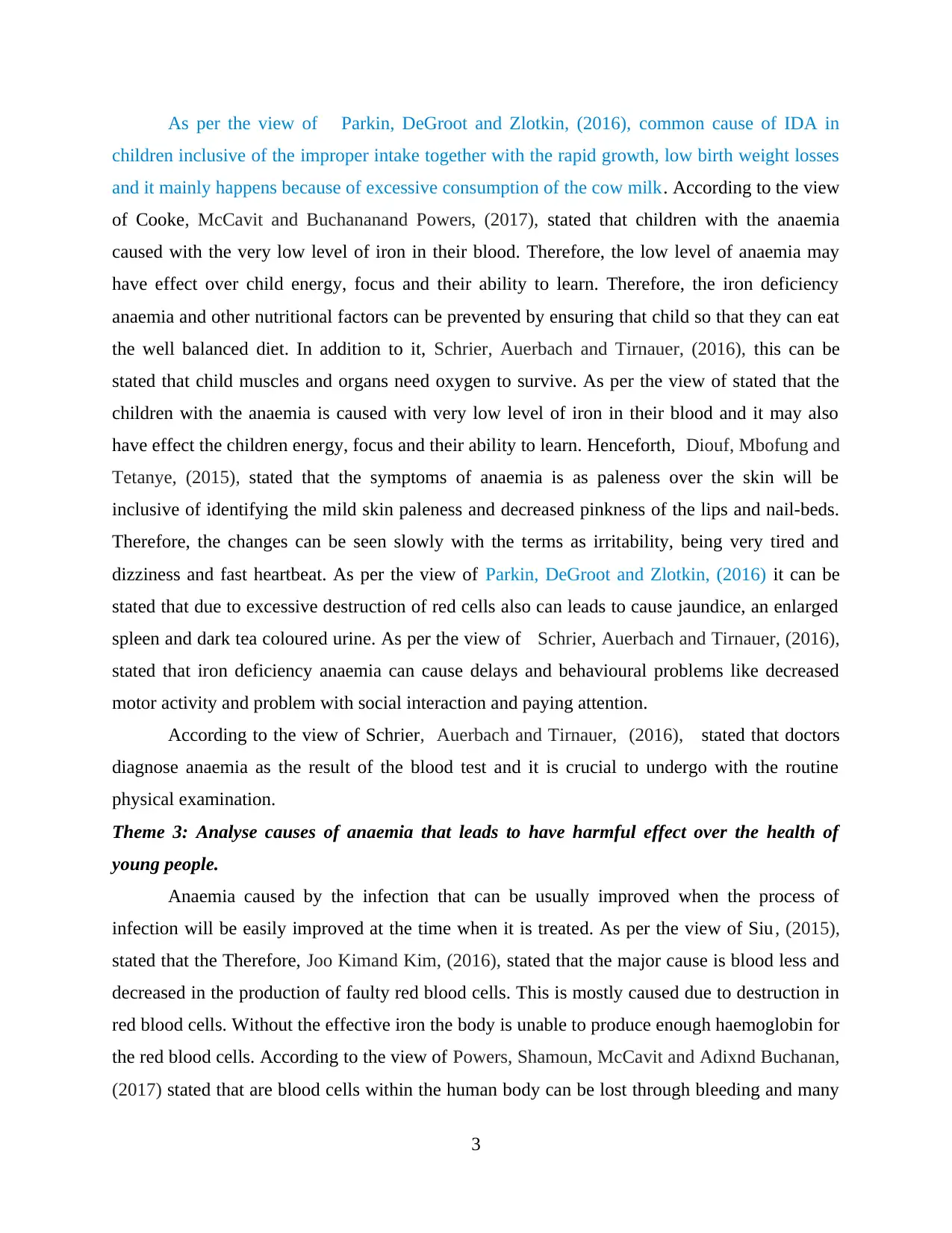
As per the view of Parkin, DeGroot and Zlotkin, (2016), common cause of IDA in
children inclusive of the improper intake together with the rapid growth, low birth weight losses
and it mainly happens because of excessive consumption of the cow milk. According to the view
of Cooke, McCavit and Buchananand Powers, (2017), stated that children with the anaemia
caused with the very low level of iron in their blood. Therefore, the low level of anaemia may
have effect over child energy, focus and their ability to learn. Therefore, the iron deficiency
anaemia and other nutritional factors can be prevented by ensuring that child so that they can eat
the well balanced diet. In addition to it, Schrier, Auerbach and Tirnauer, (2016), this can be
stated that child muscles and organs need oxygen to survive. As per the view of stated that the
children with the anaemia is caused with very low level of iron in their blood and it may also
have effect the children energy, focus and their ability to learn. Henceforth, Diouf, Mbofung and
Tetanye, (2015), stated that the symptoms of anaemia is as paleness over the skin will be
inclusive of identifying the mild skin paleness and decreased pinkness of the lips and nail-beds.
Therefore, the changes can be seen slowly with the terms as irritability, being very tired and
dizziness and fast heartbeat. As per the view of Parkin, DeGroot and Zlotkin, (2016) it can be
stated that due to excessive destruction of red cells also can leads to cause jaundice, an enlarged
spleen and dark tea coloured urine. As per the view of Schrier, Auerbach and Tirnauer, (2016),
stated that iron deficiency anaemia can cause delays and behavioural problems like decreased
motor activity and problem with social interaction and paying attention.
According to the view of Schrier, Auerbach and Tirnauer, (2016), stated that doctors
diagnose anaemia as the result of the blood test and it is crucial to undergo with the routine
physical examination.
Theme 3: Analyse causes of anaemia that leads to have harmful effect over the health of
young people.
Anaemia caused by the infection that can be usually improved when the process of
infection will be easily improved at the time when it is treated. As per the view of Siu, (2015),
stated that the Therefore, Joo Kimand Kim, (2016), stated that the major cause is blood less and
decreased in the production of faulty red blood cells. This is mostly caused due to destruction in
red blood cells. Without the effective iron the body is unable to produce enough haemoglobin for
the red blood cells. According to the view of Powers, Shamoun, McCavit and Adixnd Buchanan,
(2017) stated that are blood cells within the human body can be lost through bleeding and many
3
children inclusive of the improper intake together with the rapid growth, low birth weight losses
and it mainly happens because of excessive consumption of the cow milk. According to the view
of Cooke, McCavit and Buchananand Powers, (2017), stated that children with the anaemia
caused with the very low level of iron in their blood. Therefore, the low level of anaemia may
have effect over child energy, focus and their ability to learn. Therefore, the iron deficiency
anaemia and other nutritional factors can be prevented by ensuring that child so that they can eat
the well balanced diet. In addition to it, Schrier, Auerbach and Tirnauer, (2016), this can be
stated that child muscles and organs need oxygen to survive. As per the view of stated that the
children with the anaemia is caused with very low level of iron in their blood and it may also
have effect the children energy, focus and their ability to learn. Henceforth, Diouf, Mbofung and
Tetanye, (2015), stated that the symptoms of anaemia is as paleness over the skin will be
inclusive of identifying the mild skin paleness and decreased pinkness of the lips and nail-beds.
Therefore, the changes can be seen slowly with the terms as irritability, being very tired and
dizziness and fast heartbeat. As per the view of Parkin, DeGroot and Zlotkin, (2016) it can be
stated that due to excessive destruction of red cells also can leads to cause jaundice, an enlarged
spleen and dark tea coloured urine. As per the view of Schrier, Auerbach and Tirnauer, (2016),
stated that iron deficiency anaemia can cause delays and behavioural problems like decreased
motor activity and problem with social interaction and paying attention.
According to the view of Schrier, Auerbach and Tirnauer, (2016), stated that doctors
diagnose anaemia as the result of the blood test and it is crucial to undergo with the routine
physical examination.
Theme 3: Analyse causes of anaemia that leads to have harmful effect over the health of
young people.
Anaemia caused by the infection that can be usually improved when the process of
infection will be easily improved at the time when it is treated. As per the view of Siu, (2015),
stated that the Therefore, Joo Kimand Kim, (2016), stated that the major cause is blood less and
decreased in the production of faulty red blood cells. This is mostly caused due to destruction in
red blood cells. Without the effective iron the body is unable to produce enough haemoglobin for
the red blood cells. According to the view of Powers, Shamoun, McCavit and Adixnd Buchanan,
(2017) stated that are blood cells within the human body can be lost through bleeding and many
3
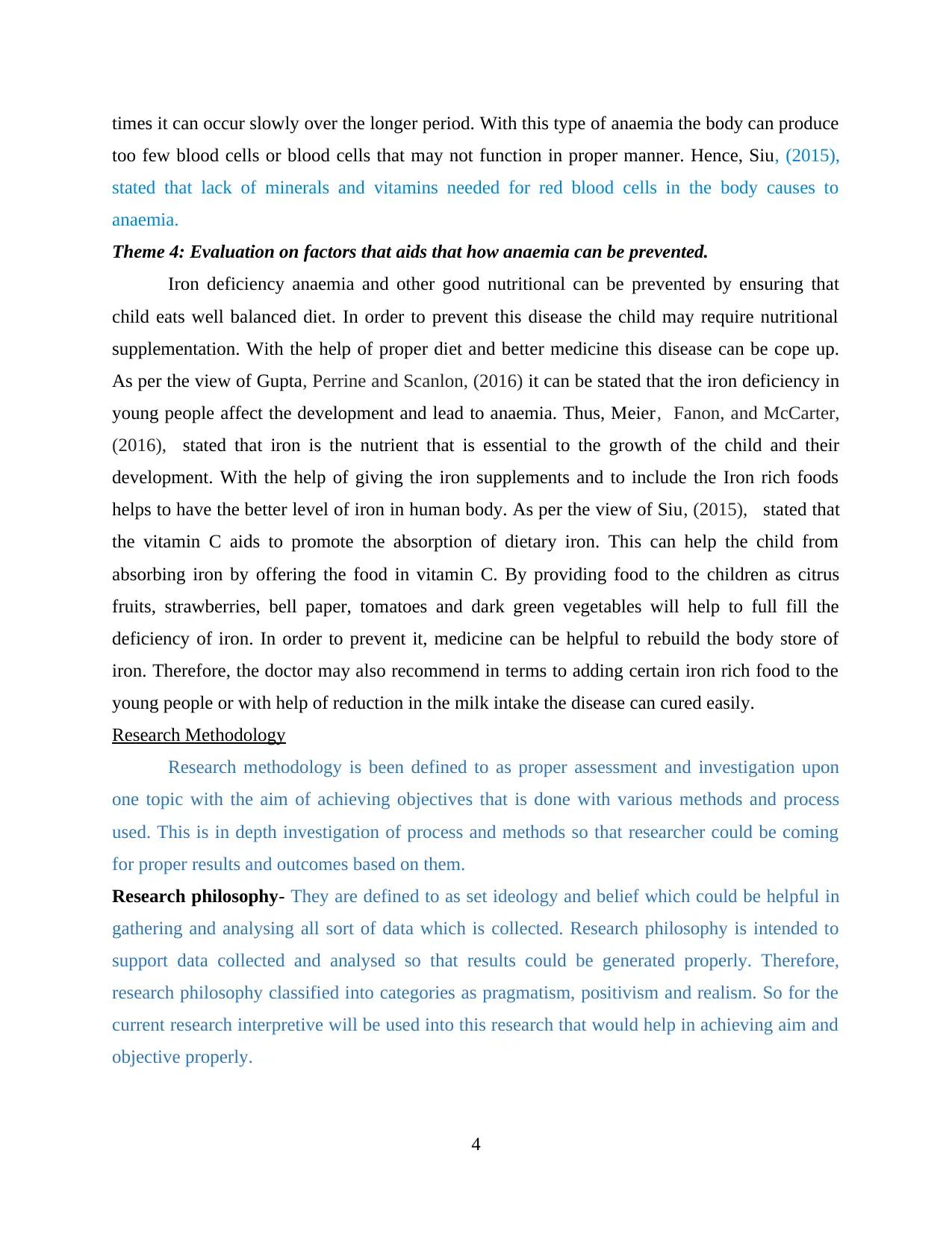
times it can occur slowly over the longer period. With this type of anaemia the body can produce
too few blood cells or blood cells that may not function in proper manner. Hence, Siu, (2015),
stated that lack of minerals and vitamins needed for red blood cells in the body causes to
anaemia.
Theme 4: Evaluation on factors that aids that how anaemia can be prevented.
Iron deficiency anaemia and other good nutritional can be prevented by ensuring that
child eats well balanced diet. In order to prevent this disease the child may require nutritional
supplementation. With the help of proper diet and better medicine this disease can be cope up.
As per the view of Gupta, Perrine and Scanlon, (2016) it can be stated that the iron deficiency in
young people affect the development and lead to anaemia. Thus, Meier, Fanon, and McCarter,
(2016), stated that iron is the nutrient that is essential to the growth of the child and their
development. With the help of giving the iron supplements and to include the Iron rich foods
helps to have the better level of iron in human body. As per the view of Siu, (2015), stated that
the vitamin C aids to promote the absorption of dietary iron. This can help the child from
absorbing iron by offering the food in vitamin C. By providing food to the children as citrus
fruits, strawberries, bell paper, tomatoes and dark green vegetables will help to full fill the
deficiency of iron. In order to prevent it, medicine can be helpful to rebuild the body store of
iron. Therefore, the doctor may also recommend in terms to adding certain iron rich food to the
young people or with help of reduction in the milk intake the disease can cured easily.
Research Methodology
Research methodology is been defined to as proper assessment and investigation upon
one topic with the aim of achieving objectives that is done with various methods and process
used. This is in depth investigation of process and methods so that researcher could be coming
for proper results and outcomes based on them.
Research philosophy- They are defined to as set ideology and belief which could be helpful in
gathering and analysing all sort of data which is collected. Research philosophy is intended to
support data collected and analysed so that results could be generated properly. Therefore,
research philosophy classified into categories as pragmatism, positivism and realism. So for the
current research interpretive will be used into this research that would help in achieving aim and
objective properly.
4
too few blood cells or blood cells that may not function in proper manner. Hence, Siu, (2015),
stated that lack of minerals and vitamins needed for red blood cells in the body causes to
anaemia.
Theme 4: Evaluation on factors that aids that how anaemia can be prevented.
Iron deficiency anaemia and other good nutritional can be prevented by ensuring that
child eats well balanced diet. In order to prevent this disease the child may require nutritional
supplementation. With the help of proper diet and better medicine this disease can be cope up.
As per the view of Gupta, Perrine and Scanlon, (2016) it can be stated that the iron deficiency in
young people affect the development and lead to anaemia. Thus, Meier, Fanon, and McCarter,
(2016), stated that iron is the nutrient that is essential to the growth of the child and their
development. With the help of giving the iron supplements and to include the Iron rich foods
helps to have the better level of iron in human body. As per the view of Siu, (2015), stated that
the vitamin C aids to promote the absorption of dietary iron. This can help the child from
absorbing iron by offering the food in vitamin C. By providing food to the children as citrus
fruits, strawberries, bell paper, tomatoes and dark green vegetables will help to full fill the
deficiency of iron. In order to prevent it, medicine can be helpful to rebuild the body store of
iron. Therefore, the doctor may also recommend in terms to adding certain iron rich food to the
young people or with help of reduction in the milk intake the disease can cured easily.
Research Methodology
Research methodology is been defined to as proper assessment and investigation upon
one topic with the aim of achieving objectives that is done with various methods and process
used. This is in depth investigation of process and methods so that researcher could be coming
for proper results and outcomes based on them.
Research philosophy- They are defined to as set ideology and belief which could be helpful in
gathering and analysing all sort of data which is collected. Research philosophy is intended to
support data collected and analysed so that results could be generated properly. Therefore,
research philosophy classified into categories as pragmatism, positivism and realism. So for the
current research interpretive will be used into this research that would help in achieving aim and
objective properly.
4
⊘ This is a preview!⊘
Do you want full access?
Subscribe today to unlock all pages.

Trusted by 1+ million students worldwide
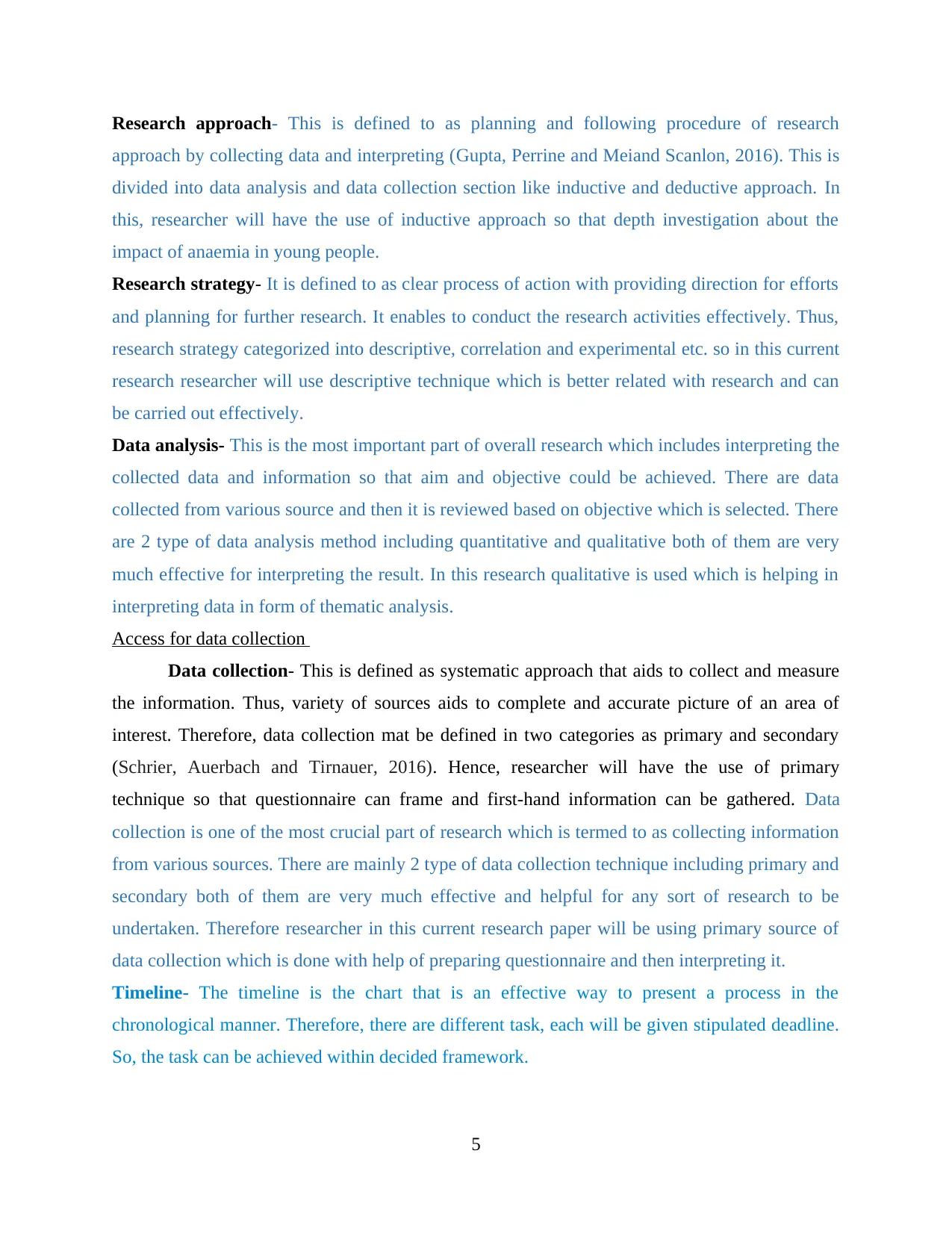
Research approach- This is defined to as planning and following procedure of research
approach by collecting data and interpreting (Gupta, Perrine and Meiand Scanlon, 2016). This is
divided into data analysis and data collection section like inductive and deductive approach. In
this, researcher will have the use of inductive approach so that depth investigation about the
impact of anaemia in young people.
Research strategy- It is defined to as clear process of action with providing direction for efforts
and planning for further research. It enables to conduct the research activities effectively. Thus,
research strategy categorized into descriptive, correlation and experimental etc. so in this current
research researcher will use descriptive technique which is better related with research and can
be carried out effectively.
Data analysis- This is the most important part of overall research which includes interpreting the
collected data and information so that aim and objective could be achieved. There are data
collected from various source and then it is reviewed based on objective which is selected. There
are 2 type of data analysis method including quantitative and qualitative both of them are very
much effective for interpreting the result. In this research qualitative is used which is helping in
interpreting data in form of thematic analysis.
Access for data collection
Data collection- This is defined as systematic approach that aids to collect and measure
the information. Thus, variety of sources aids to complete and accurate picture of an area of
interest. Therefore, data collection mat be defined in two categories as primary and secondary
(Schrier, Auerbach and Tirnauer, 2016). Hence, researcher will have the use of primary
technique so that questionnaire can frame and first-hand information can be gathered. Data
collection is one of the most crucial part of research which is termed to as collecting information
from various sources. There are mainly 2 type of data collection technique including primary and
secondary both of them are very much effective and helpful for any sort of research to be
undertaken. Therefore researcher in this current research paper will be using primary source of
data collection which is done with help of preparing questionnaire and then interpreting it.
Timeline- The timeline is the chart that is an effective way to present a process in the
chronological manner. Therefore, there are different task, each will be given stipulated deadline.
So, the task can be achieved within decided framework.
5
approach by collecting data and interpreting (Gupta, Perrine and Meiand Scanlon, 2016). This is
divided into data analysis and data collection section like inductive and deductive approach. In
this, researcher will have the use of inductive approach so that depth investigation about the
impact of anaemia in young people.
Research strategy- It is defined to as clear process of action with providing direction for efforts
and planning for further research. It enables to conduct the research activities effectively. Thus,
research strategy categorized into descriptive, correlation and experimental etc. so in this current
research researcher will use descriptive technique which is better related with research and can
be carried out effectively.
Data analysis- This is the most important part of overall research which includes interpreting the
collected data and information so that aim and objective could be achieved. There are data
collected from various source and then it is reviewed based on objective which is selected. There
are 2 type of data analysis method including quantitative and qualitative both of them are very
much effective for interpreting the result. In this research qualitative is used which is helping in
interpreting data in form of thematic analysis.
Access for data collection
Data collection- This is defined as systematic approach that aids to collect and measure
the information. Thus, variety of sources aids to complete and accurate picture of an area of
interest. Therefore, data collection mat be defined in two categories as primary and secondary
(Schrier, Auerbach and Tirnauer, 2016). Hence, researcher will have the use of primary
technique so that questionnaire can frame and first-hand information can be gathered. Data
collection is one of the most crucial part of research which is termed to as collecting information
from various sources. There are mainly 2 type of data collection technique including primary and
secondary both of them are very much effective and helpful for any sort of research to be
undertaken. Therefore researcher in this current research paper will be using primary source of
data collection which is done with help of preparing questionnaire and then interpreting it.
Timeline- The timeline is the chart that is an effective way to present a process in the
chronological manner. Therefore, there are different task, each will be given stipulated deadline.
So, the task can be achieved within decided framework.
5
Paraphrase This Document
Need a fresh take? Get an instant paraphrase of this document with our AI Paraphraser
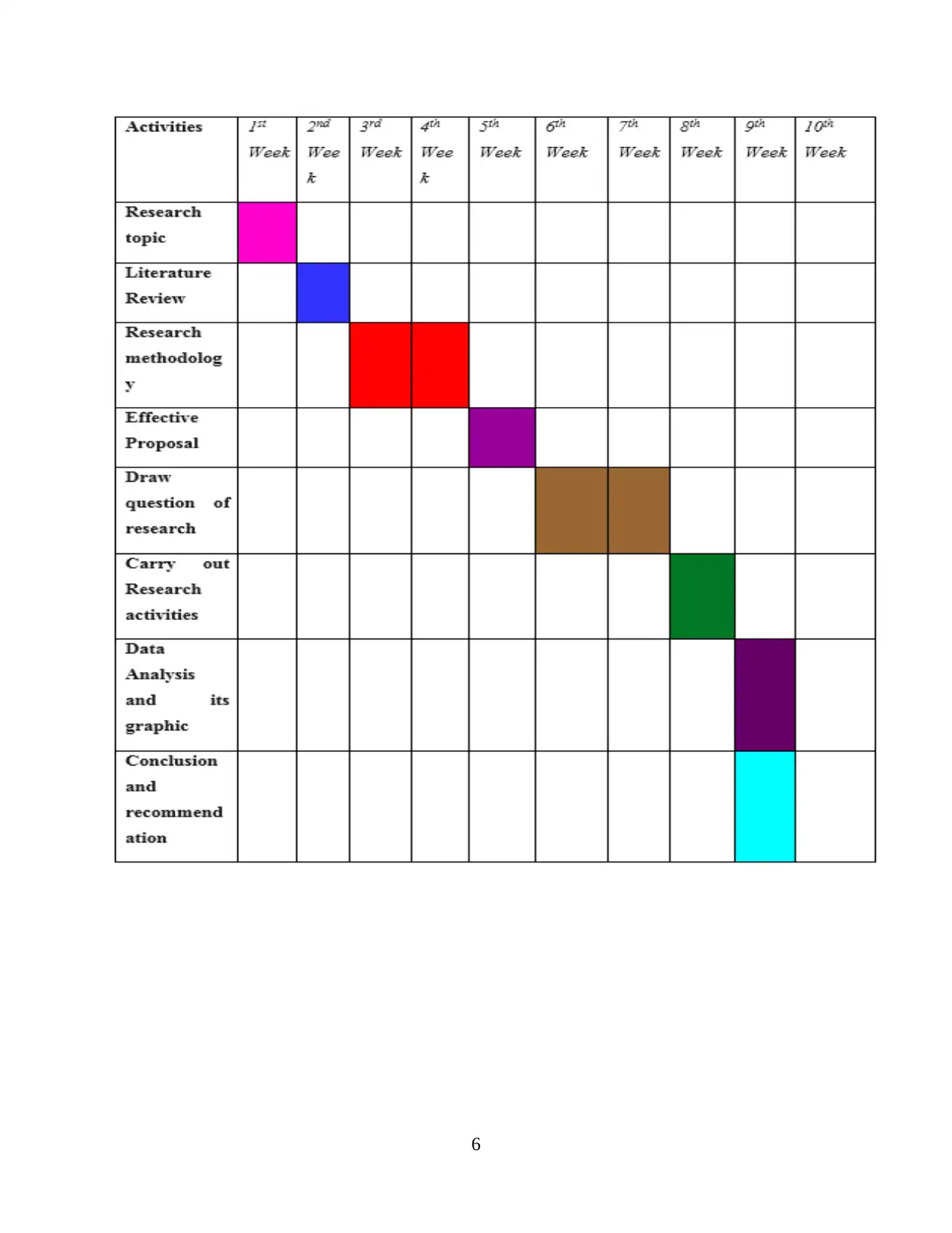
6
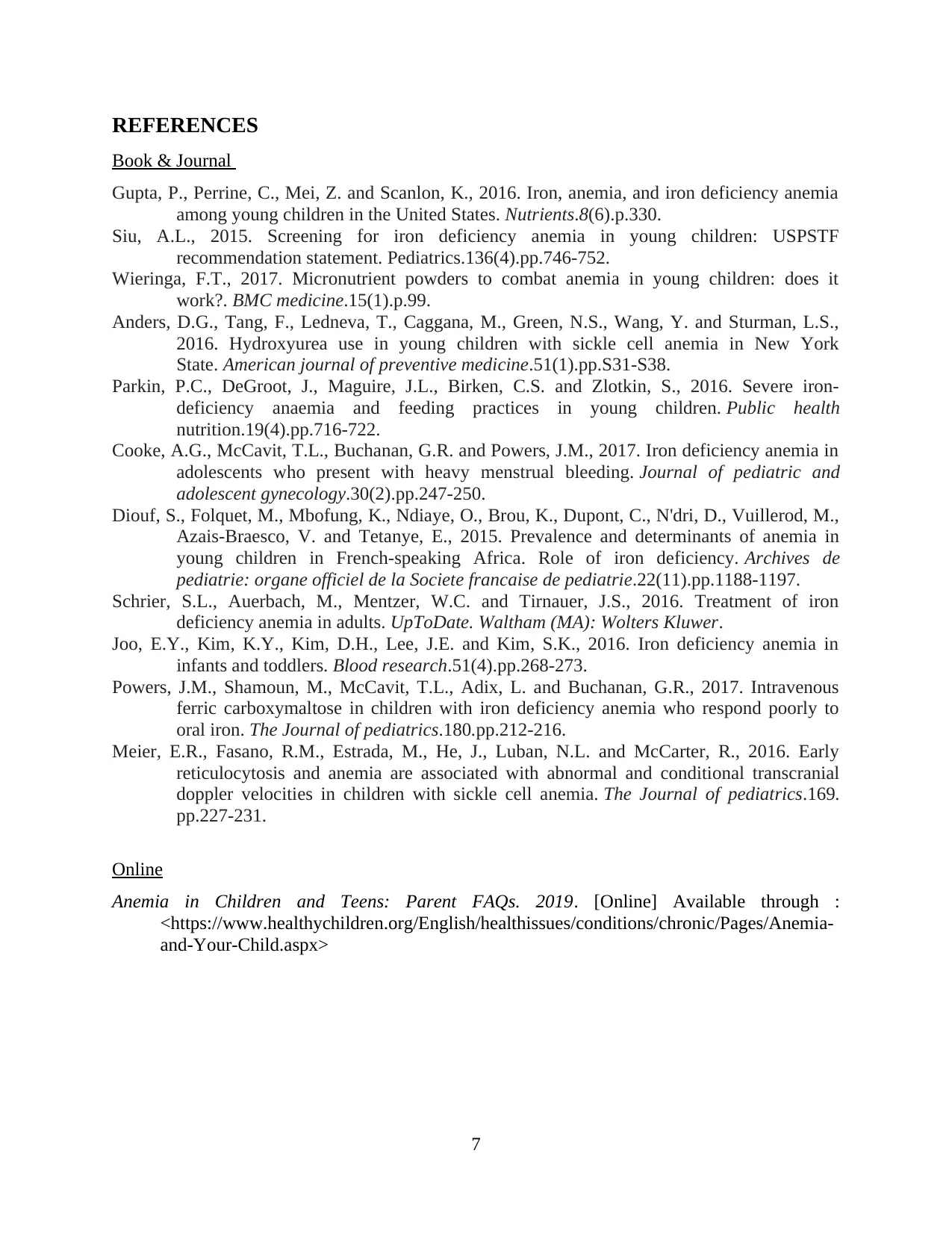
REFERENCES
Book & Journal
Gupta, P., Perrine, C., Mei, Z. and Scanlon, K., 2016. Iron, anemia, and iron deficiency anemia
among young children in the United States. Nutrients.8(6).p.330.
Siu, A.L., 2015. Screening for iron deficiency anemia in young children: USPSTF
recommendation statement. Pediatrics.136(4).pp.746-752.
Wieringa, F.T., 2017. Micronutrient powders to combat anemia in young children: does it
work?. BMC medicine.15(1).p.99.
Anders, D.G., Tang, F., Ledneva, T., Caggana, M., Green, N.S., Wang, Y. and Sturman, L.S.,
2016. Hydroxyurea use in young children with sickle cell anemia in New York
State. American journal of preventive medicine.51(1).pp.S31-S38.
Parkin, P.C., DeGroot, J., Maguire, J.L., Birken, C.S. and Zlotkin, S., 2016. Severe iron-
deficiency anaemia and feeding practices in young children. Public health
nutrition.19(4).pp.716-722.
Cooke, A.G., McCavit, T.L., Buchanan, G.R. and Powers, J.M., 2017. Iron deficiency anemia in
adolescents who present with heavy menstrual bleeding. Journal of pediatric and
adolescent gynecology.30(2).pp.247-250.
Diouf, S., Folquet, M., Mbofung, K., Ndiaye, O., Brou, K., Dupont, C., N'dri, D., Vuillerod, M.,
Azais-Braesco, V. and Tetanye, E., 2015. Prevalence and determinants of anemia in
young children in French-speaking Africa. Role of iron deficiency. Archives de
pediatrie: organe officiel de la Societe francaise de pediatrie.22(11).pp.1188-1197.
Schrier, S.L., Auerbach, M., Mentzer, W.C. and Tirnauer, J.S., 2016. Treatment of iron
deficiency anemia in adults. UpToDate. Waltham (MA): Wolters Kluwer.
Joo, E.Y., Kim, K.Y., Kim, D.H., Lee, J.E. and Kim, S.K., 2016. Iron deficiency anemia in
infants and toddlers. Blood research.51(4).pp.268-273.
Powers, J.M., Shamoun, M., McCavit, T.L., Adix, L. and Buchanan, G.R., 2017. Intravenous
ferric carboxymaltose in children with iron deficiency anemia who respond poorly to
oral iron. The Journal of pediatrics.180.pp.212-216.
Meier, E.R., Fasano, R.M., Estrada, M., He, J., Luban, N.L. and McCarter, R., 2016. Early
reticulocytosis and anemia are associated with abnormal and conditional transcranial
doppler velocities in children with sickle cell anemia. The Journal of pediatrics.169.
pp.227-231.
Online
Anemia in Children and Teens: Parent FAQs. 2019. [Online] Available through :
<https://www.healthychildren.org/English/healthissues/conditions/chronic/Pages/Anemia-
and-Your-Child.aspx>
7
Book & Journal
Gupta, P., Perrine, C., Mei, Z. and Scanlon, K., 2016. Iron, anemia, and iron deficiency anemia
among young children in the United States. Nutrients.8(6).p.330.
Siu, A.L., 2015. Screening for iron deficiency anemia in young children: USPSTF
recommendation statement. Pediatrics.136(4).pp.746-752.
Wieringa, F.T., 2017. Micronutrient powders to combat anemia in young children: does it
work?. BMC medicine.15(1).p.99.
Anders, D.G., Tang, F., Ledneva, T., Caggana, M., Green, N.S., Wang, Y. and Sturman, L.S.,
2016. Hydroxyurea use in young children with sickle cell anemia in New York
State. American journal of preventive medicine.51(1).pp.S31-S38.
Parkin, P.C., DeGroot, J., Maguire, J.L., Birken, C.S. and Zlotkin, S., 2016. Severe iron-
deficiency anaemia and feeding practices in young children. Public health
nutrition.19(4).pp.716-722.
Cooke, A.G., McCavit, T.L., Buchanan, G.R. and Powers, J.M., 2017. Iron deficiency anemia in
adolescents who present with heavy menstrual bleeding. Journal of pediatric and
adolescent gynecology.30(2).pp.247-250.
Diouf, S., Folquet, M., Mbofung, K., Ndiaye, O., Brou, K., Dupont, C., N'dri, D., Vuillerod, M.,
Azais-Braesco, V. and Tetanye, E., 2015. Prevalence and determinants of anemia in
young children in French-speaking Africa. Role of iron deficiency. Archives de
pediatrie: organe officiel de la Societe francaise de pediatrie.22(11).pp.1188-1197.
Schrier, S.L., Auerbach, M., Mentzer, W.C. and Tirnauer, J.S., 2016. Treatment of iron
deficiency anemia in adults. UpToDate. Waltham (MA): Wolters Kluwer.
Joo, E.Y., Kim, K.Y., Kim, D.H., Lee, J.E. and Kim, S.K., 2016. Iron deficiency anemia in
infants and toddlers. Blood research.51(4).pp.268-273.
Powers, J.M., Shamoun, M., McCavit, T.L., Adix, L. and Buchanan, G.R., 2017. Intravenous
ferric carboxymaltose in children with iron deficiency anemia who respond poorly to
oral iron. The Journal of pediatrics.180.pp.212-216.
Meier, E.R., Fasano, R.M., Estrada, M., He, J., Luban, N.L. and McCarter, R., 2016. Early
reticulocytosis and anemia are associated with abnormal and conditional transcranial
doppler velocities in children with sickle cell anemia. The Journal of pediatrics.169.
pp.227-231.
Online
Anemia in Children and Teens: Parent FAQs. 2019. [Online] Available through :
<https://www.healthychildren.org/English/healthissues/conditions/chronic/Pages/Anemia-
and-Your-Child.aspx>
7
⊘ This is a preview!⊘
Do you want full access?
Subscribe today to unlock all pages.

Trusted by 1+ million students worldwide
1 out of 9
Related Documents
Your All-in-One AI-Powered Toolkit for Academic Success.
+13062052269
info@desklib.com
Available 24*7 on WhatsApp / Email
![[object Object]](/_next/static/media/star-bottom.7253800d.svg)
Unlock your academic potential
Copyright © 2020–2025 A2Z Services. All Rights Reserved. Developed and managed by ZUCOL.





